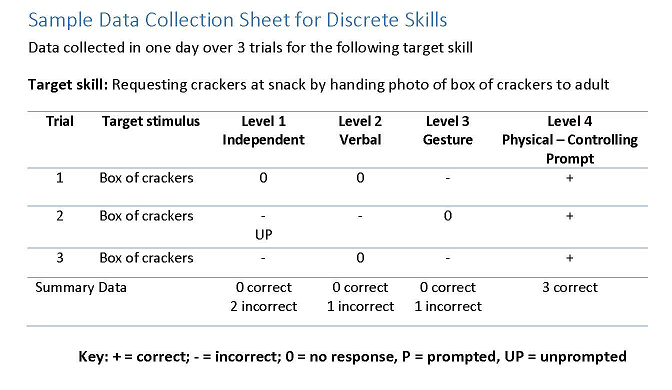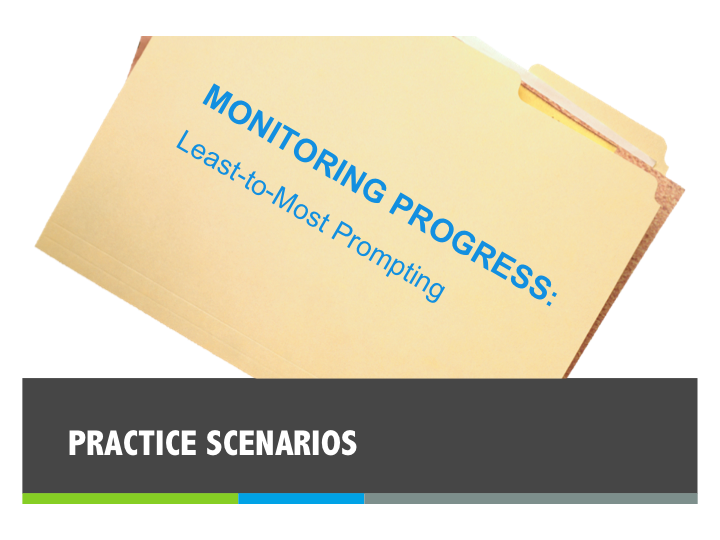Step 3 Monitoring Progress
![]()

To monitor the effectiveness of least-to most-prompting, it is important to gather data and evaluate what types of responses are being made by the toddler.
Step 3.1 Schedule and record data
Schedule and record data on each type of response. Select a schedule for collecting and reviewing data for on-going monitoring. A schedule for collecting and reviewing the data should specify how frequently you will monitor (e.g. at each home visit, during each routine or activity on a daily basis).
Decide whether to record each trial during the activity or routine or to only record the last trial in the activity or routine.
Record each type of response that occurs. A suggested response coding scheme is provided in the images below.


Download the Sample Data Collection Sheet from the Module Resources section.
Step 3.1a Record data on four types of potential responses
Toddler responses to the prompts in using the target skills are not always successful. Therefore, the responses of the toddler can be thought of as correct (+) or incorrect (-), either with prompting or without prompting.
If the toddler completes the expected steps of washing hands without prompts, all responses would be coded as unprompted correct (+).
EI providers should track all of these responses because their occurrence provides valuable information about the toddler’s performance and progress. The data sheet should reflect each trial.
Review more about the four types of potential responses:
Step 3.2 Analyze the data
Analyze the data to determine if progress is being made.
Determine whether the unprompted and prompted correct responses total 100% of the toddler’s performance.
First, calculate the percentage of the unprompted correct, the percentage of the prompted correct, and the percentage of the incorrect responses. This should equal 100%.
Determine if the percentage of unprompted correct responses are increasing over time.
Next, review the data, based on your schedule of monitoring, to determine if the percentage of unprompted correct responses is increasing over time. If your target skill/behavior is a chained task, you will need to analyze each step of the chain.
Step 3.3 Use information from data
Use the data to modify, revise, or change the use of least-to-most prompting to enhance acquisition of the target skill or behavior.
Analysis of the data can help pinpoint problems in implementing the prompting procedure correctly or guide decisions about when the prompting procedure needs to be changed. Revisions or modifications to prompting might include:
- changing the type of controlling prompt needed,
- reducing the number of prompts within the hierarchy,
- changing the cue or response interval, and
- when to begin fading the prompts.
Based on the data and using the strategies on how to fade prompts that were discussed in the Step 1.11, remember to fade prompts in the hierarchy.
Common Problems and Solutions When Using Prompting
Problem |
Solution |
|
The toddler consistently makes errors at the final level in the hierarchy. |
Select a new, more controlling prompt |
|
The toddler consistently makes errors at an intermediate level. |
|
|
The toddler consistently waits for a prompt instead of attempting to respond at the independent level. |
Differentially reinforce prompted and unprompted correct responses or eliminate reinforcement for prompted correct responses |
|
The toddler consistently fails to respond at any level, including the final level. |
Find a more powerful reinforcer. |
EXAMPLE
The EI provider continues to monitor progress of the toddler asking for crackers. She reviews data collected over a period of one week.

The data in the chart reflects that the controlling prompt has shifted from physical to gestural, given that the toddler is responding correctly at that intermediate prompting level.
A decision would be made to reduce the number of levels in the prompt, now only 3 levels.
Practice Scenario: Monitoring Least-to-Most Prompting
The practice scenario will open in a new browser tab/window.
When you have finished reviewing,
return to the module and take the Knowledge Check.
Knowledge Check
Question:
What are the types of responses that should be collected when monitoring progress?
Question:
What can the data collected tell you about the effectiveness of the least-to-most prompting procedure?
Question:
What are some common mistakes that can occur when using least-to-most-prompting?


